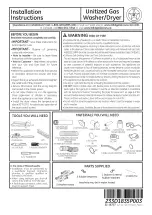
11
Connect remaining wires
23.
Place hooked ends of remaining wires under outer terminal block
screws (hooks facing right). Tighten screws.
VeNTINg reQUIreMeNTS
WARNING:
To reduce the risk of fire, this dryer MUST BE
EXHAUSTED OUTDOORS.
IMPORTANT:
Observe all governing codes and ordinances.
Dryer exhaust must not be connected into any gas vent,
chimney, wall, ceiling, attic, crawlspace, or a concealed space
of a building. Only rigid or flexible metal vent shall be used for
exhausting.
n
Only a 4" (102 mm) heavy metal exhaust
vent and clamps may be used.
n
Do not use plastic or metal foil vent.
n
Recommended for best drying performance and to prevent
crushing and kinking.
4"
(102 mm)
4"
(102 mm)
B
A
4"
(102 mm)
2½"
(64 mm)
Rigid metal vent:
n
Must be fully extended and supported in final dryer location.
n
Remove excess to avoid sagging and kinking that may result
in reduced airflow and poor performance.
n
Do not install in enclosed walls, ceilings, or floors.
n
The total length should not exceed 7
3
/
4
ft. (2.4 m).
Flexible metal vent:
(Acceptable only if accessible to clean)
NOTE:
If using an existing vent system, clean lint from entire
length of the system and make sure exhaust hood is not plugged
with lint. Replace plastic or metal foil vents with rigid metal or
flexible metal vents. Review Vent system chart and if necessary,
modify existing vent system to achieve best drying performance.
Exhaust hoods:
n
Must be at least 12" (305 mm) from ground or any object that
may obstruct exhaust (such as flowers, rocks, bushes, or
snow).
Recommended styles:
A. Louvered hood
B. Box hood
Acceptable styles:
C. Angled hood
n
An exhaust hood should cap vent to keep rodents and insects
from entering home.
n
Do not use exhaust hood with a magnetic latch.
Connect external ground wire
24.
Connect external ground wire to the green ground terminal
screw. Finally, reinsert tab of terminal block cover into slot of
dryer rear panel. Secure cover with hold-down screw.
Now, go
to Venting Requirements.


































